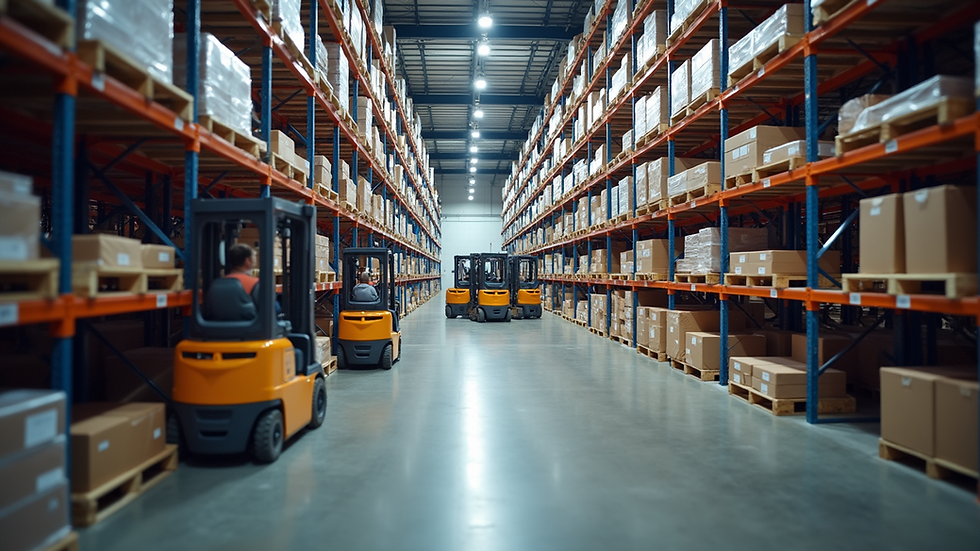Top Benefits of Logistics Optimization
- Iriana Ch Urdaneta

- Nov 10
- 3 min read
In today’s fast-paced world, businesses face increasing pressure to deliver products quickly and efficiently. Managing the movement of goods from suppliers to customers is a complex task that requires careful planning and execution. This is where logistics optimization plays a crucial role. By streamlining supply chain processes, companies can reduce costs, improve customer satisfaction, and gain a competitive edge.
Understanding the Benefits of Logistics in Business
Logistics is the backbone of any supply chain. It involves transportation, warehousing, inventory management, and order fulfillment. When these elements work seamlessly, businesses can operate smoothly and meet customer demands effectively. The benefits of logistics extend beyond just moving products; they impact overall business performance.
One major advantage is cost reduction. Efficient logistics minimizes unnecessary expenses such as fuel consumption, storage fees, and labor costs. For example, optimizing delivery routes can save fuel and reduce vehicle wear and tear. Similarly, better inventory management prevents overstocking or stockouts, which can tie up capital or lead to lost sales.
Another benefit is improved delivery speed and reliability. Customers today expect fast shipping and accurate order fulfillment. A well-optimized logistics system ensures that products reach customers on time, enhancing their experience and loyalty. This can be a decisive factor in retaining customers and attracting new ones.

Efficient warehouse organization supports faster order processing and shipping
Key Benefits of Logistics for Supply Chain Efficiency
Logistics optimization offers several specific benefits that directly impact supply chain efficiency:
Enhanced Inventory Control: Accurate tracking and forecasting help maintain optimal stock levels. This reduces holding costs and prevents delays caused by missing items.
Better Resource Utilization: Optimizing routes and schedules ensures vehicles and personnel are used effectively, reducing idle time and increasing productivity.
Increased Flexibility: A responsive logistics system can quickly adapt to changes in demand or supply disruptions, minimizing downtime.
Improved Supplier and Customer Relationships: Timely deliveries and transparent communication build trust with partners and customers.
Sustainability Gains: Efficient logistics reduces carbon footprint by cutting unnecessary transportation and energy use.
For instance, a company using advanced software to plan delivery routes can avoid traffic congestion and reduce travel distances. This not only saves money but also lowers emissions, contributing to environmental goals.
How to Implement Effective Logistics Strategies
Implementing logistics optimization requires a strategic approach. Here are practical steps businesses can take:
Analyze Current Processes: Identify bottlenecks and inefficiencies in the existing supply chain.
Leverage Technology: Use software tools for route planning, inventory management, and real-time tracking.
Train Staff: Ensure employees understand new systems and procedures to maximize benefits.
Collaborate with Partners: Work closely with suppliers and carriers to align goals and improve coordination.
Monitor and Adjust: Continuously track performance metrics and make adjustments as needed.
For example, integrating GPS tracking with delivery management software allows companies to monitor shipments in real time and respond quickly to delays or issues.

Efficient transportation management reduces delivery times and costs
Practical Examples of Logistics Optimization in Action
Many companies have successfully improved their operations through logistics optimization. Consider a retailer that implemented a centralized warehouse system combined with automated inventory tracking. This change reduced order processing time by 30% and cut shipping errors significantly.
Another example is a manufacturer that adopted just-in-time inventory practices supported by precise logistics planning. This approach minimized storage costs and ensured components arrived exactly when needed, avoiding production delays.
Small businesses can also benefit by using third-party logistics providers who specialize in efficient distribution networks. Outsourcing logistics can provide access to expertise and technology without large upfront investments.
Future Trends Enhancing Logistics Benefits
The logistics industry is evolving rapidly with new technologies and practices. Some emerging trends include:
Artificial Intelligence and Machine Learning: These tools analyze vast amounts of data to predict demand, optimize routes, and improve decision-making.
Automation and Robotics: Automated warehouses and delivery drones increase speed and reduce human error.
Sustainability Initiatives: Green logistics practices focus on reducing environmental impact through alternative fuels and eco-friendly packaging.
Blockchain for Transparency: Secure and transparent tracking of goods enhances trust and reduces fraud.
Businesses that stay ahead by adopting these innovations will continue to reap the benefits of logistics optimization and maintain a competitive advantage.
Maximizing Your Business Potential with Logistics
Optimizing logistics is not just about cutting costs; it’s about creating a resilient and responsive supply chain that supports growth. By focusing on efficiency, accuracy, and sustainability, companies can improve customer satisfaction and increase profitability.
To start, consider evaluating your current logistics processes and exploring tools that can help streamline operations. Whether through technology adoption, staff training, or strategic partnerships, every step toward better logistics management adds value.
For more insights and resources on how to enhance your supply chain, explore logistics optimization solutions tailored to your business needs.
By embracing these strategies, your business can unlock new opportunities and thrive in a competitive marketplace.










Comments